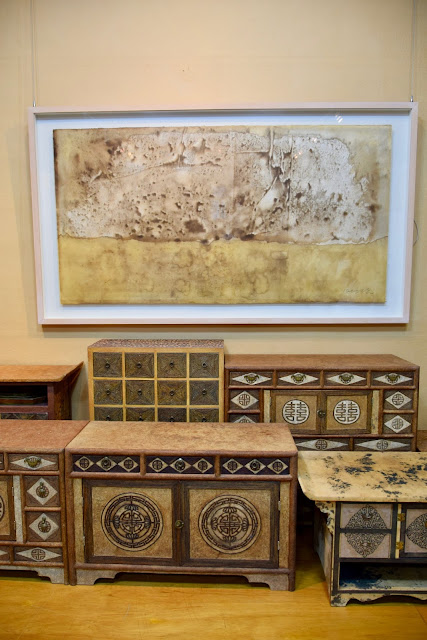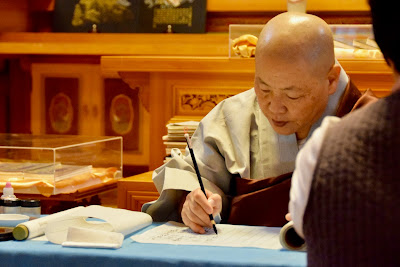My twin sister, a Buddhist nun ………
One of the many highlights of my journey was a visit to the Youngdam
Hanji Museum to meet the director Young Dam, a Buddhist Nun who's spent
decades making Hanji paper and doing 2D and 3 D Hanji art.
I was impressed that
she’d done her research about me before I arrived and knew what work I’d want to see on this visit but what surprised me the most was that she realized we were the same age and
decided that because we both love Hanji and have similar interests we must be ‘Hanji twins’.
At first I was a little apprehensive to meet her as my image of a
Buddhist nun was of a person who was quiet, genteel and almost ethereal, who
obediently went about her daily rituals, never questioning, demanding nor being
confronting. I’m not saying any of those
traits are undesirable; in fact I admire them and those that have the willpower
to be devotionally serene and obedient but I was surprised when this jovial
lady came out to greet us and starting ordering her female helpers around to
get us drinks and snacks. The ladies soon
scurried around and ushered us into a large, somewhat bare looking room with
comfortable IKEA chairs set up for us to sit on. Shoes were taken off at the door in true
Asian style and we positioned ourselves in the chairs and Young Dam sat herself
down on the floor in front of us.
 |
| Being a wonderful host |
She was immediately engaging, telling funny stories and making us
feel at home as well as being very interested in hearing from me about my Hanji
and where I was on my journey. She wanted to know what inspired me to work with
Hanji, especially from outside of Korea, and how I kept going with my
passion on a daily basis.
When it was time to leave her home I was having trouble putting my
shoes back on and Young Dam quietly bent down and put them on for me. I felt so
humbled by this lovely lady.
We then moved to her Museum, a testament to all the work
she’s been doing with Hanji.
Everything in there she's made
herself. She began at an early age growing mulberry trees, stripping the bark,
making the pulp and making her own papers.
The Museum had two large cabinets full of her paper and I
was totally awestruck at the amount she’d made and what she'd done with the papers over the last
40 years or so. I felt very overwhelmed
by her achievements, especially when compared to mine.
She was so full of enthusiasm to show and tell me things that she
got straight into it on entering the Museum which I was delighted with but, it
created a lot of frustration for the filming crew as they tried to capture
scenes which they weren’t quite ready for. We took lots of takes, as she was
determined that this visit was all about sharing her passion with me in the
short time that we had available and not necessarily one for making a
documentary.
Papers were quickly whisked out of her neatly stacked piles and my
lap was inundated with beautiful papers which enabled me to see the great range
she had made from the finest see through sheets with a wonderful sheen on them
(indicates that wholly organic methods were used in their production) to
marbled papers that looked like leather right through to quite thick sheets
used for the coverings of handmade books. I was particularly pleased to see the
marbled papers as I’ve only every seen them once before and my source has now
dried up so to know she has some was very exciting.
 |
| Which one shall I choose? |
It doesn’t take much for me to get excited when it comes to
beautiful papers as I can then dream of what I can make out of them!!
 |
| 3D hanji art by Young Dam |
We moved on to her 3 D Hanji art and the details were amazing. She’d used fine pieces of Jiseung (string made out of paper) to make designs on her pieces
and most of them were in the earthy colours, which I personally prefer rather than bright colours.
Her 2 D art was also great to see, as she’d
experimented with different designs when making her papers then added pieces to
them as well. I feel very inspired to try more of this type of artwork.
 |
| 2D Hanji art by Young Dam |
Over on the side was a full set of Hanji dolls that she’d made
depicting a country scene with children and adults, some with ailments and
others flushed with colour and over to the side was a woman mixing up some herbs for the sick. I’ve seen quite a few
of these before but Young Dam’s were beautifully made with fine features
and each with a very realistic composure.
 |
| Hanji dolls |
We bonded very quickly and I could have spent days chatting with her
about her work as I felt a great connection with her passion for Hanji as well
as her as a person.
 |
| Young Dam's Buddhist temple |
Next we headed up to her temple to see where she spends a lot of her
time in devotions and in writing out Buddhist scripts onto Hanji books that she’s
made. Two of her friends were in the
temple doing very intricate drawings with gold paint on Hanji. They drew lines
without anything to follow, just from what inspires them, and when completed
these were to be placed inside the temple as an offering to Buddha.
 |
| Writing Buddhist sayings in Hanji books |
 |
| Fine drawings in gold paint |
It was a beautifully serene place and inside and outside the
building it had intricately carved and brightly painted architecture and inside
there was a huge gold Buddha taking centre stage. There were two rows of low
tables in front of the Buddha statue and this is where they worked, sometimes
for hours at a time doing what they love, in devotion to their God.
I’m sure
time wasn’t an issue when entranced in their sacred place.
 |
| Beautiful details inside the temple |
After the wander around we were invited to share a meal with Young
Dam, so whilst the film crew kept filming in the museum and temple, we headed
into a very basic kitchen and shared mountain herbs and vegetables with our
host. Her wonderful helpers had prepared everything for us before we arrived and
when we’d finish a particular vegetable, with the flick of her hand, Young Dam
ushered for more to be served to complete our meal. Such generosity is common in Buddhist
temples but this was particularly special.
To end our visit, and whilst the film crew ate, we were shown back
into the room we’d started in and gestured to sit down. Before I knew it my feet were up in the air
and a footstool was underneath them, soothing music had been put on and Young
dam slipped out of the room to entertain the other guests whilst eating their
meal. I sat back, smiled to myself and chatted to Hayley, my interpreter, and mused over the whole experience.
It's a part of Korean culture to be hospitable and invite strangers into their
homes and temples, it's a part of Korean culture for paper artists to make and enjoy Hanji, it's a part of Korean
culture to want to share their traditions, and this Australian was left feeling
thankful, exhilarated and humbled to have had this amazing experience.










Great story, Jan!
ReplyDeleteFascinating! Thank you for taking us with you on this unique journey!
ReplyDelete